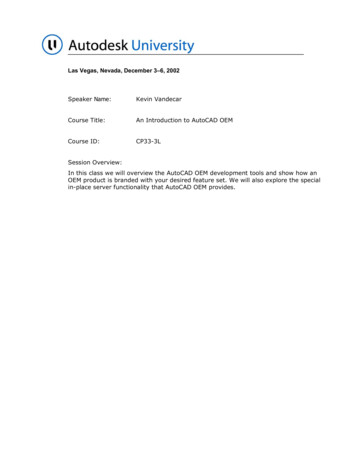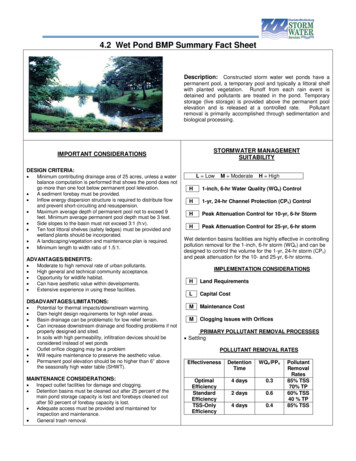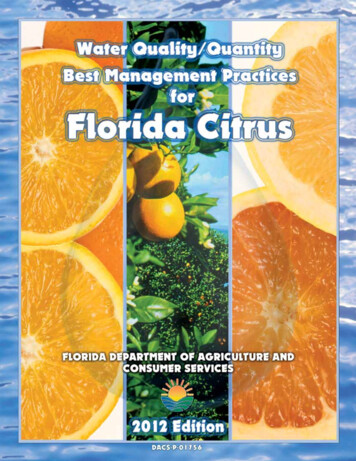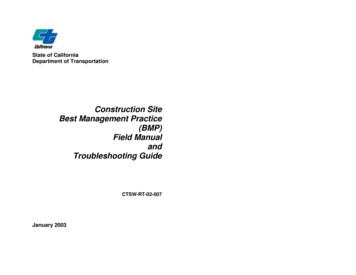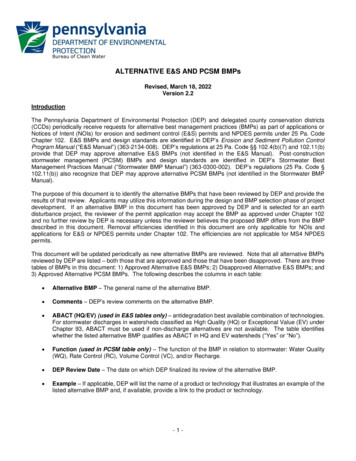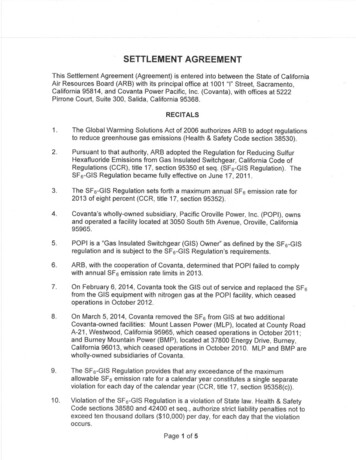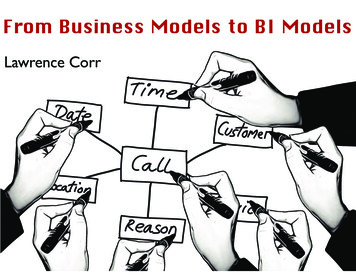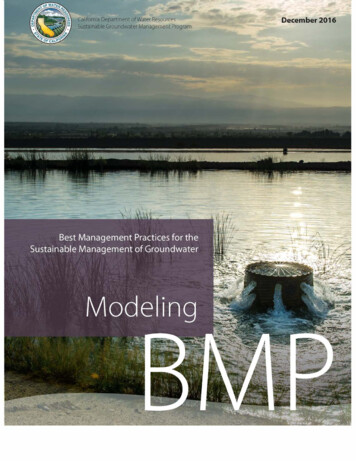
Transcription
California Department of Water Resources[ISusta nable Groundwater Management ProgramBest Management Practices for theSustainable Management of GroundwaterModelingBMPDecember 2016
State of CaliforniaEdmund G. Brown Jr., GovernorCalifornia Natural Resources AgencyJohn Laird, Secretary for Natural ResourcesDepartment of Water ResourcesMark W. Cowin, DirectorCarl A. Torgersen, Chief Deputy DirectorOffice of the Chief CounselSpencer KennerPublic Affairs OfficeEd WilsonOffice of Workforce EqualityStephanie VarrelmanPolicy AdvisorWaiman YipGovernment and Community LiaisonAnecita S. AgustinezLegislative Affairs OfficeKasey Schimke, Ass’t Dir.Deputy DirectorsGary BardiniIntegrated Water ManagementWilliam CroyleStatewide Emergency Preparedness and SecurityMark AndersonState Water ProjectJohn Pacheco (Acting)California Energy Resources SchedulingKathie KishabaBusiness OperationsTaryn RavazziniSpecial InitiativesDivision of Integrated Regional Water ManagementArthur Hinojosa Jr., ChiefPrepared under the direction of:David Gutierrez, Sustainable Groundwater Management Program ManagerRich Juricich, Sustainable Groundwater Management BranchPrepared by:Trevor Joseph, BMP Project ManagerTimothy GodwinDan McManusMark NordbergHeather ShannonSteven SpringhornWith assistance from:DWR Region Office Staff
December 2016Modeling BMPModelingBest Management Practice1. OBJECTIVEThe objective of this Best Management Practice (BMP) is to assist with the use anddevelopment of groundwater and surface water models. The California Department ofWater Resources (the Department or DWR) has developed this document as part of theobligation in the Technical Assistance chapter (Chapter 7) of the SustainableGroundwater Management Act (SGMA) to support the long-term sustainability ofCalifornia’s groundwater basins. Information in this BMP provides technical assistanceto Groundwater Sustainability Agencies (GSAs) and other stakeholders on how toaddress modeling requirements outlined in the Groundwater Sustainability Plan (GSP)Emergency Regulations (GSP Regulations). This BMP identifies available resources tosupport the development of groundwater and surface water models.This BMP includes the following sections:1. Objective. The objective and outline of the contents of this BMP.2. Use and Limitations. A description of the use and limitation of this BMP.3. Modeling Fundamentals. A description of fundamental modeling concepts.4. Relationship of modeling to other BMPs. A description of how modeling relatesto other BMPs and is a tool used to develop other GSP requirements.5. Technical Assistance. A description of technical assistance for the developmentof a model, potential sources of information, and relevant datasets that can beused to further define model components.6. Key Definitions. Definitions relevant for this BMP as provided in the GSPRegulations, Basin Boundary Regulations, and SGMA.7. Related Materials. References and other materials related to the development ofmodels.2. USE AND LIMITATIONSBMPs developed by the Department provide technical guidance to GSAs and otherstakeholders. Practices described in these BMPs do not replace the GSP Regulations, nordo they create new requirements or obligations for GSAs or other stakeholders. Inaddition, using this BMP to develop a GSP does not equate to an approvaldetermination by the Department. All references to GSP Regulations relate to Title 23 ofthe California Code of Regulations (CCR), Division 2, Chapter 1.5, and Subchapter 2. Allreferences to SGMA relate to California Water Code sections in Division 6, Part 2.74.California Department of Water Resources1
December 2016Modeling BMP3. MODELING FUNDAMENTALSAs modified from Barnett and others (2012), a model is any computational method thatrepresents an approximation of the hydrologic system. While models are, by definition,a simplification of a more complex reality, they have proven to be useful tools overseveral decades for addressing a range of groundwater problems and supporting thedecision-making process. Models can be useful tools for estimating the potentialhydrologic effects of proposed water management activities.Surface water and groundwater systems are affected by natural processes and humanactivity. They require targeted and ongoing management to maintain surface water andgroundwater resources within acceptable limits, while providing desired economic andsocial benefits. Sustainable groundwater management and policy decisions must be basedon knowledge of the past and present behavior of the surface and groundwater system,the likely response to future changes and management actions, and the understandingof the uncertainty in those responses.The location, timing, and magnitude of hydrologic responses to natural or humaninduced events depend on a wide range of factors. Such factors include the nature andduration of the event that is impacting groundwater, the subsurface properties, and theconnection with surface water features such as rivers and oceans. Through observationof these characteristics, a conceptual understanding of the system can be developed.Often observational data are scarce (both in space and time), so understanding of thesystem remains limited and generally uncertain.Models provide insight into the complex system behavior and (when appropriatelydesigned) can assist in developing conceptual understanding. Models provide animportant framework that brings together conceptual understanding, data, and sciencein a hydrologically and geologically consistent manner. In addition, models canestimate and reasonably bound future groundwater conditions, support decisionmaking about monitoring networks and management actions, and allow the explorationof alternative management approaches. However, there should be no expectation that asingle ‘true’ model exists. All models and model results will have some level ofuncertainty. Models can provide decision makers an estimate of the predictiveuncertainty that exists in model forecasts. By gaining a sense of the magnitude of theuncertainty in model predictions, decision makers can better accommodate the realitythat all model results are imperfect forecasts and actual basin responses to managementactions will vary from those predicted by modeling.California Department of Water Resources2
December 2016Modeling BMPGENERAL TYPES OF MODELS AND MODELING SOFTWAREThere are various modeling approaches, methods, and software that can be used forGSP development and implementation. This section provides a general description of afew widely used types of models and the variety of software typically used formodeling. These model types are not mutually exclusive. For example, an integratedgroundwater and surface water model can also be described as a numerical model.Each GSA is responsible for determining the appropriate modeling method, software,and the level of detail needed to demonstrate that undesirable results can be avoided andthe sustainability goal in each basin is likely to be achieved within 20 years of GSPimplementation. A table of select, currently available, modeling codes (the modelcomputation engine) and applications (the constructed model including inputs) isprovided in Appendix A.TYPES OF MODELSConceptual ModelsA conceptual model is often considered the first step in understanding the groundwaterflow system and developing a mathematical model. A conceptual model includes anarrative interpretation and graphical representation of a basin based on knowncharacteristics and current management actions. Conceptual models do not necessarilyinclude quantitative values. For more details on developing a conceptual model, pleaserefer to the Hydrogeologic Conceptual Model (HCM) BMP.Mathematical ModelsA model that simulates groundwater flow or solute transport by solving an equation, orseries of equations, that reasonably represents the physical flow and transport processesis referred to as a mathematical model. Mathematical models differ from conceptualmodels in that they are capable of providing quantitative estimates of the water budgetcomponents. Mathematical models are often divided into two categories: analytical andnumerical models or tools.Analytical Models and ToolsAnalytical models generally require assumptions that significantly simplify the physicalsystem being evaluated. For example, topographic boundary conditions are generallylimited to simple geometric shapes in these solutions, and aquifer properties are oftenrequired to be homogeneous and isotropic. The physical configuration of themanagement action is also typically idealized for the purposes of analysis and,therefore, influences related to project geometry are ignored. Often only one component(a measured or simulated value or relationship) of the groundwater system is evaluatedCalifornia Department of Water Resources3
December 2016Modeling BMPat a time, and this approach omits the evaluation of potential interactions with othercomponents. For example, a spreadsheet could use a simple equation to estimate theaquifer drawdown in one location based on pumping at another location, withoutconsidering the potential influence on nearby streams.However, analytical models and tools can successfully and inexpensively be employedto gain strong conceptual and general quantitative understanding of groundwater basindynamics, which includes interactions with pumping, groundwater storage,groundwater quality, seawater intrusion, land subsidence, and interaction with surfacewater. Therefore, the applicability of this approach is most suited to initial scopingstudies or basins with simple hydrologic conditions or easily idealized basins. Thisanalysis may be limited when used as the only modeling tool.Numerical Models and ToolsNumerical modeling tools are widely used in groundwater flow and transport analysisto evaluate the change to the groundwater system caused by changes in conditions dueto management actions, changes in population and land use, climate change, or otherfactors. These numerical models allow for a more realistic representation of the physicalsystem, including geologic layering, complex boundary conditions, and stresses due topumping, recharge and land use demands. GSPs developed for complex basins withsignificant groundwater withdrawals and/or surface water - groundwater interactionmay require the use of a numerical groundwater - surface water model to demonstratethat the GSP will avoid undesirable results and achieve the sustainability goal withinthe basin. Several of the available modeling codes and associated applications arediscussed in more detail in Appendix A.Integrated Hydrologic Water ModelsA fully integrated surface water and groundwater model refers to a suite of codes thatjointly solve the numerical solutions for surface processes (such as irrigation deliveriesand stream diversions), surface flows and groundwater heads together. Many modelsinclude the ability to simultaneously simulate streamflow and its interconnection withthe aquifer system.Coupled Groundwater and Surface Water ModelsA coupled groundwater and surface water model uses separate models for surfacewater and the groundwater systems. Coupled models are set up such that the solutionfrom one model (i.e., surface water modeling output) can be used as input into thesecond model (i.e., groundwater model) to solve the groundwater flow equations and toconsider the stresses (boundary conditions) imposed by the surface water information.California Department of Water Resources4
December 2016Modeling BMPTransport ModelsTransport model codes add a layer of complexity beyond what is provided bygroundwater-flow models. These models allow for the assessment of a variety ofproblems, including the potential migration of existing contaminant plumes due tomanagement actions, or the changes in groundwater quality over time after aremediation project is implemented. These types of models are not as widely used forwater resources planning, but need to be considered for basins in which existingcontamination impairs the use of groundwater as the source of supply and/or affectother areas of the basin now or as a potential result of future management actions.TYPES OF MODELING SOFTWAREGroundwater modeling typically requires the use of a number of software types,including the following (modified from Barnett and others, 2012): The model code that solves the equations for groundwater flow and/or solutetransport, sometimes called simulation software or the computational engine A graphical user interface (GUI) that facilitates preparation of data files for themodel code, runs the model code and allows visualization and analysis of results Software for processing spatial data, such as a geographic information system (GIS),and software for representing hydrogeological conceptual models Software that supports model calibration, sensitivity analysis and uncertaintyanalysis Programming and scripting software that allows additional calculations to beperformed outside of or in parallel with any of the above types of software A wide range of model codes to solve problems related to groundwater flow and/ortransport, such as model codes that simulate farm water management, plant-waterinteractions, unsaturated zone flow and transport processes, stream flow processes,surface water - groundwater interactions, land subsidence, watershed processes,climate, geochemical reactions, economic water management optimization, orparameter calibrationSome software is public domain and open-source (freely available and able to bemodified by the user) and some is commercial and closed (proprietary design that isonly available in an executable form that cannot be modified by the user).California Department of Water Resources5
December 2016Modeling BMPSome software fits several of the above categories; for example, a model code may besupplied with its own GUI or a GIS may be supplied with a scripting language. SomeGUIs support one model code while others support many. Most model codes that solvethe groundwater flow and/or transport equation have an integrated capability to alsosimulate some or many of the related processes listed above, such as surface water groundwater interaction.COMMON MODEL USESThe following provides a partial list of general and SGMA-related uses for modelsGeneral Uses (modified from Barnett and others, 2012) Improving hydrogeological understanding (synthesis of data).Aquifer simulation (evaluation of aquifer behavior).Calculating and verifying water budget components, such as recharge, discharge,change in storage and the interaction between surface water and groundwatersystems (water resources assessment).Predicting impacts of alternative hydrological or development scenarios (to assistdecision-making).Managing resources (assessment of alternative policies).Sensitivity and uncertainty analysis (to guide data collection and risk-baseddecision-making).Visualization (to communicate aquifer behavior).Providing a repository for information and data that influence groundwaterconditions.GSP-Related Uses Developing an understanding and assessment of how historical conditionsconcerning hydrology, water demand, and surface water supply availability orreliability have impacted the ability to operate the basin within sustainable yield.Assessing how annual changes in historical inflows, outflows, and changes inbasin storage vary by water year type (hydrology) and water supply reliability.Evaluating how the surface and groundwater systems respond to the annualchanges in the water budget inflows and outflows.Identifying which management actions and water budget situations commonlyresult in overdraft conditions or undesirable results.California Department of Water Resources6
December 2016 Modeling BMPFacilitating the estimate of sustainable yield for the basin.Optimizing proposed projects and management actions and evaluating thepotential effects those activities have on achieving the sustainability goal for thebasin.Evaluating future scenarios of water demand uncertainty associated withprojected changes in local land use planning, population growth, and climate.Informing monitoring requirements.Informing development and quantification of sustainable management criteria,such as the sustainability goal, undesirable results, minimum thresholds, andmeasureable objectives.Helping identify potential projects and management actions and optimizing theirdesign to achieve the sustainability goal for the basin within 20 years of GSPimplementation.Identifying data gaps and uncertainty associated with key water budgetcomponents and model forecasts, and developing an understanding of how thesegaps and uncertainty may affect implementation of proposed projects and watermanagement actions.MODELS IN REFERENCE TO THE GSP REGULATIONSDeveloping and applying models to aid in determining sustainable groundwatermanagement results in multiple benefits to GSAs and stakeholders. Constructing andcalibrating the model improves understanding of the critical processes that influencesustainability indicators within the basin. The application of the model to forecast theinfluence of projects and management actions on basin conditions provides aframework within which a GSA can screen and select appropriate projects andmanagement actions that lead to the achievement of the sustainability goal for the basin.Additionally, models can play a critical role in simulating the changing climateconditions that may occur during the 50-year planning and implementation horizonrequired under SGMA. It should be noted that in general, groundwater and surfacewater models are more effective at comparing the benefits and impacts of variousmanagement strategies with respect to one another rather than predicting exactmanagement outcomes. So while a model can assist in selecting the best alternativefrom a variety of options, uncertainty will still remain in the forecasted outcome of aparticular alternative. Adaptive management will always be a necessary component ofprogram implementation.California Department of Water Resources7
December 2016Modeling BMPA significant consideration that must be addressed by all GSAs is whether modeling isnecessary or required for developing and implementing its GSP. In most basins, thespatial and temporal complexity of the data will require some application of modelingto accurately assess the individual and cumulative effects of proposed projects andmanagement actions on avoiding or eliminating undesirable results and achieving thebasin’s sustainability goal. It is each GSA’s role to carefully consider if changing basinconditions and proposed projects and management actions have the potential to triggerundesirable results within the basin or in adjacent basins, and whether a model isnecessary to demonstrate that the proposed projects and management actions willachieve the sustainability goal. Therefore, the use of models for developing a GSP ishighly recommended, but not required. The use of a model will ultimately depend onthe individual characteristics and complexity of the basin setting, the presence orabsence of undesirable results, and the presence or absence of interconnected surfacewater systems. As stated in GSP Regulation sections §354.18 (f) and §354.28(c)(6), “if anumerical groundwater and surface water model is not used to quantify the waterbudget and depletions of interconnected surface water, the GSP shall identify anddescribe an equally effective method, tool, or analytical model to accomplish theserequirements”.Similar to the question of whether models should be used during GSP development isthe question of the appropriate level of model complexity. Simple models require fewerdata, less complex software, and are, therefore, often less expensive, and have muchshorter run times. These characteristics are advantageous when focusing on a singleundesirable result. However, simple models may overlook important systemcomponents and the interconnectedness of undesirable results, and may be difficult tocalibrate to historical data. Complex models can incorporate more data and professionaljudgment. Therefore, they often result in a more accurate representation of thegroundwater system. However, complex models are more expensive and difficult tobuild, require more data and more technical expertise, and the complexity can lead to afalse impression of accuracy; a complex model may in fact be less accurate.Fundamentally, a good model strategy is to follow the principle of parsimony: to buildthe simplest model that honors all relevant available data and knowledge, whileproviding a reasonable modeling tool to achieve the desired decision support at adesirable level of certainty. It may be necessary to use complex models to assess certainundesirable results, and it may be possible to use simple models to assess otherundesirable results.Some guidance on what might influence model complexity is provided in the modelingconsiderations section of this BMP. Since significant professional judgment goes into theCalifornia Department of Water Resources8
December 2016Modeling BMPdevelopment of a model, two models of the same basin – even if they are built with thesame model code - are likely to differ in their design and their outcome. Where multiplemodels exist, differences between model outcomes, after a careful assessment of thedifferences in model design and assumptions, may provide an important opportunity tofurther assess uncertainty in predicted outcomes and to further direct future datacollection programs. Importantly, multiple models with differing outcomes should notbe interpreted a priori as one model being (more) right and others being (more) wrong.While models are useful and often invaluable tools for understanding a basin andpredicting future basin conditions, in most cases, they are not the only available meansfor demonstrating that a basin has met its sustainability goal. Satisfactorilydemonstrating that all undesirable results have been avoided and the sustainability goalhas been met will be a function of the data collected and reported during GSPimplementation.4. RELATIONSHIP OF MODELING TO OTHER BMPSThe purposes of modeling in the broader context of SGMA implementation include:1. Supporting the development of the water budget2. inabilitygoal,undesirable results, minimum thresholds, and measurable objectives)3. rojectsandmanagement actions to address undesirable results that exist or are likely to existin the future4. Supporting the refinement of the monitoring network in the basin over timeModeling is also linked to other related BMPs as illustrated in Figure 1. This figureprovides the context of the BMPs as they relate to logical progression to sustainability asoutlined in the GSP Regulations. The modeling BMP is part of the planning step in theGSP Regulations.California Department of Water Resources9
December 2016Modeling BMPFigure 1 – Logical Progression of Basin Activities Needed to Increase BasinSustainabilityCalifornia Department of Water Resources10
December 2016Modeling BMP5. TECHNICAL ASSISTANCEThis section provides technical assistance and guidance to support the development ofmodels under SGMA and the GSP Regulations, including potential sources ofinformation and relevant datasets that can be used to develop and implement thevarious modeling components.GUIDING PRINCIPLES FOR MODELS USED IN SUPPORT OF GSPSThe Department is providing the following four modeling principles to help fosterSGMA’s intent to promote transparency, coordination, and data sharing. They helpguide GSAs in their selection and use of models for sustainable groundwatermanagement, and expedite Department review of GSP-related modeling analysis andfindings.1. Model documentation (documentation of model codes, algorithms, inputparameters, calibration, output results, and user instructions) is publiclyavailable at no cost. In particular, the model documentation should explain (orrefer to available literature that explains) how the mathematical equations for thevarious model code components were derived from physical principles andsolved, and guidance on limitations of the model code.2. The mathematical foundation and model code have been peer reviewed for theintended use. Peer review is not intended to be a “stamp-of-approval” ordisapproval of the model code. Instead, the goal of peer review is to informstakeholders and decision-makers as to whether a given model code is a suitabletool for the selected application, and whether there are limits on the temporal orspatial uses of the model code, or other analytic limits.3. The GSP descriptions of the conceptual model, the site-specific modelassumptions, input parameters, calibration, application scenarios, and analyticalresults demonstrate that the quantification of the forecasted water budget,sustainable management criteria (sustainability goal, undesirable results,minimum thresholds, and measurable objectives), proposed projects andmanagement actions are reasonable and within the range of identifieduncertainties, to evaluate the GSP-identified outcomes of sustainability for thebasin.4. If requested, provide the Department with a free working copy of the completemodeling platform (for example native MODFLOW and IWFM input files,California Department of Water Resources11
December 2016Modeling BMPoutput files, and executables) that allows the Department to run the model,create and verify results, view input and output files, or perform any otherevaluation and verification.GENERAL MODELING REQUIREMENTS23 CCR §352.4(f) Groundwater and surface water models used for a Plan shall meet thefollowing standards:(1) The model shall include publicly available supporting documentation.(2) The model shall be based on field or laboratory measurements, or equivalentmethods that justify the selected values, and calibrated against site-specific field data.(3) Groundwater and surface water models developed in support of a Plan after theeffective date of these regulations shall consist of public domain open-source software.The intent of requiring standards for models in the GSP Regulations is to promote aconsistent approach to the development and coordination of models in California. Thiswill allow the Department to evaluate these models and related GSPs within basins andbetween basins across the state. A description of the specific modeling standards listedin §352.4(f) is provided below.(1) The model shall include publicly available supporting documentation.Models used for a GSP are required to provide publicly available supportingdocumentation in the form of:1. An explanation of the modeling code, the physical processes simulated by thecode, associated mathematical equations, and assumptions, which are typicallyfound in publicly available theoretical documentation, user instructions ormanuals. This information should be referenced by the model developer in theirdocumentation of the model application.2. A description of the model application, including the construction of the modelby the GSA that describes the conceptual model, simulation model development,assumptions, data inputs, boundary conditions, calibration, uncertainty analysis,and other applicable model application elements. This documentation should bea component of a GSP, and included as an appendix to characterize the technicalwork that went into developing and applying the model for GSP developmentand implementation. The California Water and Environmental Modeling Forum(CWEMF) has developed a framework for documenting and archiving aCalifornia Department of Water Resources12
December 2016Modeling BMPgroundwater flow model application that can be tailored for GSA use (CWEMF,2000).(2) The model shall be based on field or laboratory measurements, or equivalentmethods that justify the selected values, and calibrated against site-specific field data.The development of a mathematical model starts with assembling applicableinformation relevant to the basin or site-specific characteristics. A detailed HCM formsthe basis of the model by providing relevant physical information of the aquifer andsurface systems, as well as applicable boundary conditions of the basin and stressors(such as pumping and artificial recharge). Previous field evaluations, studies andliterature may provide additional data for the model development. For more sitespecific information, field testing can be performed, e.g., targeted aquifer tests todetermine parameters such as hydraulic conductivity, transmissivity, and storagecoefficients. In addition, field tests allow for the calibration of the model to field data.Calibration of the model should be performed by comparing simulated values toobserved field data such as groundwater levels, groundwater flow directions,groundwater discharge rates, water quality concentrations, land subsidenceobservations, measurements of surface water and groundwater exchange, or chlorideconcentrations as an indicator for seawater intrusion. Additional information on thesetopics is provided in the modeling considerations and modeling process sections.(3) Groundwater and surface water models developed in support of a Plan after theeffective date of these regulations shall consist of public domain open-source software.Public domain codes published through government agencies like the Department, theU.S. Army Corps of Engineers Hydrologic Engineering Center, and United StatesGeological Survey (USGS), are often widely distributed, relatively inexpensive, andgenerally accepted model codes with features that can be and have been used tosimulate a wide range of hydrogeological conditions. Public domain codes, includingmany listed in Appendix A, have received extensive peer review, case studiesdocument their ge
Best Management Practice (BMP) is to assist the use and with development of groundwater and surface water models. The California Department of . The physical configuration of the management action is also typically idealized for the purposes of analysis and, therefore, influences related to project geometry are ignored. .
